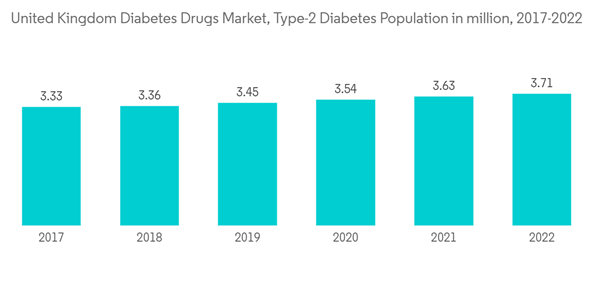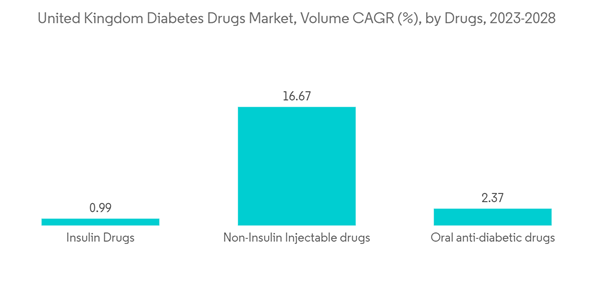The COVID-19 pandemic has had a substantial impact on the United Kingdom's diabetes drugs market. According to The British Diabetic Association, 'The pandemic has had and continues to have, a huge impact on our society. But research and data have shown that people with diabetes have been disproportionately affected by COVID-19, particularly in terms of poorer outcomes when contracting the virus. That's why preventing or delaying cases of type 2 diabetes is more important than ever before.' Within the first year since its inception, the COVID-19 pandemic has been responsible for premature deaths, particularly among older individuals. Most people who have died of COVID-19 were affected by the co-occurrence of two or more chronic conditions in the same individual. Several studies have confirmed that chronic diseases like diabetes are associated with adverse outcomes in COVID-19 patients.
Diabetic drugs are medicines developed to stabilize and control blood glucose levels amongst people with diabetes. Diabetic drugs have been potential candidates for treating diabetic patients affected by SARS-CoV-2 infection during the COVID-19 pandemic. According to The British Diabetic Association, Diabetes prevalence 2021 data shows an increase in the number of people living with a diabetes diagnosis in the UK: an increase of more than 150,000 from 2020. The rapidly increasing incidence and prevalence of diabetic patients and healthcare expenditure are indications of the increasing usage of diabetic drugs.
In May 2021, the World Health Assembly agreed on a Resolution on strengthening the prevention and control of diabetes. It recommends action in areas including increasing access to insulin; promoting convergence and harmonization of regulatory requirements for insulin and other medicines and health products for the treatment of diabetes; and assessing the feasibility and potential value of establishing a web-based tool to share information relevant to the transparency of markets for diabetes medicines and health products.
Therefore, owing to the aforementioned factors the studied market is anticipated to witness growth over the analysis period.
United Kingdom (UK) Diabetes Drugs Market Trends
The oral anti-diabetic drugs segment holds the highest market share in the United Kingdom Diabetes Drugs Market in the current year
The oral anti-diabetic drugs segment holds the highest market share of about 64.5% in the United Kingdom Diabetes Drugs Market in the current year.Oral Anti-Diabetic Drugs are available internationally and are recommended for use when escalation of treatment for type 2 diabetes is required along with lifestyle management. Oral agents are typically the first medications used in treating type 2 diabetes due to their wide range of efficacy, safety, and mechanisms of action. Anti-diabetic drugs help diabetes patients control their condition and lower the risk of diabetes complications. People with diabetes may need to take anti-diabetic drugs for their whole lives to control their blood glucose levels and avoid hypoglycemia and hyperglycemia. Oral anti-diabetic agents present the advantages of easier management and lower cost. So they became an attractive alternative to insulin with better acceptance, which enhances adherence to the treatment.
Any medicinal product commercially available in the United Kingdom is eligible for reimbursement. It means the NHS refunds the costs of the medicine to the dispensing pharmacist or doctor, apart from a few exceptions. Various steps are being taken in the direction of controlling diabetes. An electronic version of a personalized Diabetes United Kingdom Management Plan is available for completion on EMIS Web. The plan can record the objectives and steps agreed upon with the patient and generate an information prescription.
The information prescription can be printed and given to the patient, and an electronic version can be saved in the patient's care record. The Diabetes United Kingdom Management Plan protocols need to be activated and generate a pop-up alert for patients if they are pregnant, suffer from kidney disease, or a raised BP/HbA1c/Cholesterol value, and include no record of a diabetes management plan in the last 6 months. It is also applicable if there is no eGFR or ACR test record in the last 13 months and no record of a Patient Health Questionnaire recorded in the last 3 months.
Owing to the above factors, the market will likely continue to grow.
Glucagon-like Peptide-1 Receptor Agonist Segment is Expected to Dominate the United Kingdom Diabetes Drugs Market in terms of revenue over the forecast period
Glucagon-like Peptide-1 Receptor Agonist Segment is expected to dominate the United Kingdom Diabetes Drugs Market in revenue and register a CAGR of more than 2.5% over the forecast period.Glucagon-like peptide-1 receptor agonists (GLP-1RAs) are a class of medications used for treating type 2 diabetes, and some drugs are also approved for obesity. One of the benefits of this class of drugs over older insulin secretagogues, such as sulfonylureas or meglitinides, is that they include a lower risk of causing hypoglycemia. Besides being important glucose-lowering agents, GLP-1RAs contain significant anti-inflammatory and pulmonary protective effects and benefit gut microbes' composition.
The Association of British HealthTech Industries (ABHI) is a trade association for the medical technology sector in the United Kingdom. The National Service Framework (NSF) program is improving services by setting national standards to drive service quality and tackle variations in care. The Association of British HealthTech Industries launched a diabetes section, enabling diabetes technology companies to work together in the first forum of its kind. The ABHI group is for any health technology company interested in diabetes care.
The disease's growing incidence, prevalence, and progressive nature encouraged the development of new drugs to provide additional treatment options for diabetic patients. The roll-out of many new products, increasing international research collaborations in technology advancement, and increasing awareness about diabetes among the people are some market opportunities for the players in the United Kingdom diabetes drugs market.
United Kingdom (UK) Diabetes Drugs Industry Overview
The United Kingdom Diabetes Drugs Market is moderately fragmented, with major manufacturers, namely Eli Lilly, Sanofi, Novo Nordisk, and AstraZeneca, holding a presence in the region. A major share of the market is held by manufacturers concomitant with strategy-based M&A operations and constantly entering the market to generate new revenue streams and boost existing ones. These measures taken by the market players will ensure a competitive marketplace, forcing companies to experiment with new technologies.Additional Benefits:
- The market estimate (ME) sheet in Excel format
- 3 months of analyst support
This product will be delivered within 2 business days.
Table of Contents
Companies Mentioned (Partial List)
A selection of companies mentioned in this report includes, but is not limited to:
- Novo Nordisk A/S
- Takeda
- Pfizer
- Eli Lilly
- Janssen Pharmaceuticals
- Astellas
- Boehringer Ingelheim
- Merck and Co.
- AstraZeneca
- Bristol Myers Squibb
- Novartis
- Sanofi Aventis










